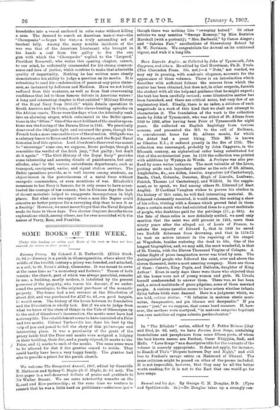Novz Legends Anglie : as Collected by John of Tynemouth,
John Capgrave, and others. Re-edited by Carl Horstman, Ph.D. "2 vols. (The Clarendon Press. 36s. net.)—A " Note," not worded, we may say in passing, with academia elegance, accounts for the appearance of these volumes. There is an introduction which describes with sufficient fulness the sources from which the matter has been obtained, but does not, in other reepects, furnish the student with all the help and guidance that he might expect ; the text has been carefully revised; some illustrative matter has been furnished, and there are critical notes, but very few of an explanatory kind. Finally, there is no index, a delirium of such magnitude in a work of this kind that we shall not attempt to characterise it. The foundation of the work is the collection made by John of Tynemouth, who was Abbot of St Albans from 1349 to 1896, after having been Prior of Tynemouth for eight years. He collected an English hagiology from various sources, and presented the MS. to the cell of Redburn, a convalescent home for St. Albans monks, for which the Abbot had a great liking. This MS. is known as Tiberius E.I. ; it suffered greatly in the fire of 1731. The collection was rearranged, probably by John Capgrave, in the fifteenth century. an alphabetical order being substituted for that of the ecclesiastical year. In 1516 the collection was printed with additions by Wynkyn de Words. A Prologue was also pre- fixed by some writer unknown. The most valuable of the Lives, putting aside such legendary matter as the arta of SS. Albans, Amphibalus, &c., are /Wan, Anselm, Augustine (of Canterbury), Baeda, Chad, Columba, Dunstan, Hugh of Lincoln, Lanfranc, Patrick, Thomas (of Canterbury), and Wilfrid. In the supple- ment, so to speak, we find among others St. Edmund (of East Anglia). If Cardinal Vaughan wishes to pursue his studies in the history of this saint, he will find interesting material. St. Edmund vehemently resented, it would seem, the making a show of his relics, visiting with a disease which proved fatal in three days a certain monk who had exhibited them to a great multitude of people, who doubtless paid for the privilege (II., p. 631). As the fate of these relics is now definitely settled, we need only mention that the saint was still present in 1291, more than ninety years after the alleged act of Louis of France, to rebuke the rapacity of Edward I., that in 1343 he saved two Norfolk fishermen from drowning, and that in 1374-75 he took an active interest in the repairing of his chapel at Waynflete, besides restoring the dead to life. One of the longest biographies, and, we may add, the most wonderful, is that of St. Ursula, with the Eleven Thousand Virgins of Cologne. A wilder flight of pious imagination never was tried by man. The distinguished people who followed the saint, over and above the eleven thousand, make a most amazing company. Here are three of them : Canute, King Pepin, and Nathalia, daughter of King Arthur ! Even in early days there were those who objected that all the bones were not of young women and girls. St. Ursula herself condescended to answer them. There was, as has been said, a mixed multitude of pious pilgrims, some of them married people. A curious question seems to have arisen whether infants dying before birth were damned. Here is a. judgment which, we are told, cmlltus dicitur. "Si infantes in matrum uteris mori- untur, dampnantur, sed pia illorum erit dampuatio." If pia means "just," as we suppose, that seems hard measure. If, how- ever, the mothers were martyred, "in matrum sanguine baptizati una cum matribus ad regna celestia perducebantur."






































 Previous page
Previous page